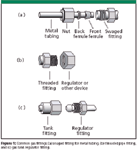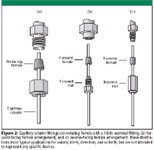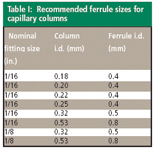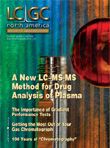Making a Great Connection
LCGC North America
This month, John Hinshaw discusses how to make, maintain, and troubleshoot various types of connections used in gas chromatographs.
Chromatographers need to use appropriate fittings and ferrules to get the most out of their instruments; proper fittings help ensure the best separation and detection performance while getting the most out of gas tanks and filters. Connections at the tank regulator, the instrument bulkhead, the column, and finally the detector all have specialized requirements and assembly procedures that should be followed. Not doing so risks wasting expensive gases and exhausting in-line filters prematurely, as well as causing excessive peak band broadening and distortion, shortened column life, and poor detector performance. Problems with gas fittings fall into two categories: leaks and band-broadening.
Leaking connections cause a number of significant problems, including poor retention time and peak area reproducibility, loss of accuracy, drifting detector baselines, high detector noise, shortened column life, and increased gas consumption. Hydrogen leakage from flame-ionization detectors or carrier-gas supplies can be a potential explosion hazard.
Contrary to intuition, a leak is not just a wasteful one-way path from the high pressures inside the tubing to the atmosphere; oxygen can diffuse from the atmosphere back into areas where its partial pressure is lower, which is always the case with gas chromatography (GC) gases except for detector fuel air. High oxygen levels in the carrier gas can cause excessive stationary phase bleed and greatly reduced column life, as well as increased detector or mass spectrometry (MS) noise and background signal levels.
Column connections require specialized low-dead-volume fittings. Internal areas in a fitting that are exposed to carrier gas but are not actively swept by carrier flow — so-called dead volumes — can cause peak broadening and tailing, especially at the low flow rates of narrow-bore columns with inner diameters under 320 μm. GC instrument manufacturers and consumable suppliers make available the specific types of fittings and ferrules for each inlet system and detector that will minimize peak broadening and tailing. It might be tempting to substitute less expensive fittings and ferrules or to keep only a few types on hand, but doing so almost compromises instrument performance.
Chromatographers always should choose nuts and ferrules that are in good condition, not worn or distorted. Proper assembly and tightening are required, and the procedures are different for new parts than for reassembly of used parts. Fittings that employ graphite or polymer composites need to be checked and maintained periodically because the soft ferrule material can deform and loosen. And finally, leak-checking is always necessary when making up new or reused fittings. As I have repeated more times than I can count, never use a soap solution to check for leaks. Liquid can flow back into a leak just as easily as can oxygen; commercial electronic leak checkers are mandatory in my lab. In the few cases where an electronic device will not respond, such as for detector air, use a pure liquid such as water or propanol.
A Word About Tubing
Three kinds of tubing material are found in gas chromatographs: copper, stainless steel, and plastic. Plastic tubing should be used only in noncritical areas where small leaks and some contamination can be tolerated, such as for the air supply to valve actuators or other pneumatically driven devices. Other than this, plastic tubing has no place in a gas chromatograph: the main problem is that plastic tubing can contaminate a gas stream with plasticizers and residual volatile chemicals, as well as with oxygen that diffuses in through the tubing walls.
All detector gases, including air, need to be provided from dedicated supplies. Otherwise, besides a contamination risk, the large air pressure fluctuations that occur upon valve actuations will not affect the detectors' outputs. For the most part, internal tubing in GC systems is made from stainless steel. Stainless steel tubing is best for the connections from gas tanks as well, although copper is just as acceptable if the fittings are not to be opened and remade more than a few times.
Fittings
The predominant type of GC gas connector is the swaged-ferrule fitting, which works by applying mechanical force with a threaded nut on a conical ferrule that is seated against the inside of a compression fitting (see Figure 1a). The ferrule is compressed inward slightly by longitudinal forces and its leading edge grips the tubing, forming a seal between the fitting and the tubing that holds the assembly in place. An additional back ferrule is often used with stainless steel or copper tubing to decouple the rotational force that is applied while tightening the nut, so that the front ferrule does not turn. This helps compensate for any slight out-of-roundness in the tubing.

Figure 1
The most familiar application of swaged fittings is the connection of carrier- and detector-gas lines to the chromatograph. Several 1/4-in. and 1/8-in. fittings usually can be found between carrier- and detector-gas supply tanks and the gas chromatograph. A number of such fittings also are employed between bulkhead connections on the back or side of a gas chromatograph and internal pressure regulators, flow controllers, or needle valves.
A second type of connection is the threaded or "pipe" fitting, shown in Figure 1b. Pipe fittings also are found at the outlet of gas tank pressure regulators. One end of the fitting screws into a threaded pressure regulator or needle valve body, while the other generally has a swage-type connection. PTFE tape wrapped around the threads seals the fitting, so no ferrules are used. These connections can be opened and resealed many times, so long as the sealant tape is renewed each time the connection is assembled. Pipe fittings also are found inside the GC system in pressure regulators and flow controllers. Sealing tape never should be used on a swaged fitting, neither on the threads, which do not form part of the seal, nor on the ferrules themselves.
A third type of commonly used fitting is found in the high-pressure connections between gas tanks and pressure regulators. These are another form of compression fitting that relies solely on tightening forces to compress one or two soft brass sealing surfaces together; there are no ferrules. Figure 1c illustrates this type of arrangement. Gas tank fittings are specific to the type and classification of gas in use, as well as the country of origin, and they are designed so that it is not possible to connect regulators and tanks that are incompatible.
One misapplication of sealing tape that I sometimes see is its use on such fittings. At best this is not effective — the tape will introduce more of a leak than it can fix — and at worse this practice is dangerous because it can lead to larger leaks of flammable hydrogen. If a regulator will not seal properly to a cylinder then replace the regulator and return the cylinder for a replacement.
Types of Swaged Connections for Capillary GC
Capillary columns are a special case for swaged fittings. Fused-silica columns cannot use conventional metallic ferrule made of steel or brass because the column will be crushed. A huge number of different-size ferrules made of plastic, composites, and a newer soft metal alloy are available instead. Among these, pure graphite is sometimes used because of its high temperature limit and easy conformity to a fitting's internal contours. Ease of removal from a column or fitting makes ferrules of polyimide or its composites with graphite the best choices for most applications. Pure polyimide ferrules are used in low-temperature applications, other than in the column oven. Graphite–polyimide composites are best used in situations that require an extended temperature range plus the ability to be reused several times. More recently, ferrules of a soft metal alloy have become available that combine high temperature limits and very low leak rates; these ferrules are especially well-suited for MS applications.

Figure 2
Capillary column ferrules are available in sizes for 1/8- and 1/16-in. fittings, drilled with one or more inner holes to match the column outer diameter. The 1/8-in. size ferrules are often termed reducing ferrules because they have an inner diameter that is significantly reduced from the nominal 1/8-in. size. These ferrules connect capillary columns to nominally 1/8-in. size swage-type fittings, as shown in Figure 2a. One familiar use is in a packed-column inlet adaptor for 530-μm i.d. columns. Simultaneous separations on two different fused-silica columns can be accomplished by connecting the columns to one inlet with a two-hole reducing ferrule. Reducing ferrules also conveniently connect 1/16- or 3/32-in. metal tubing to 1/8-in. standard swaged fittings on internal pressure regulators or flow controllers. Common reducing ferrule sizes and matching capillary column inner diameters are given in Table I.

Table I: Recommended ferrule sizes for capillary columns
Figures 2b and 2c show how 1/16-in. ferrules are applied when connecting to a capillary inlet or detector. This type of fitting can accommodate the ferrule in a forward (Figure 2b) or a reverse (Figure 2c) orientation. In the reverse orientation, the nut is drilled out, tapered, and threaded, and the ferrule goes into the nut instead of into the fitting. The ferrule is installed on the column in the reverse direction, because the conical part of the compression fitting is now inside the nut. These ferrules generally fit a nominal 1/16-in. size fitting, again with inner holes drilled for various column outer diameters.
Making Great Connections
GC users can assemble these various types of connections leak and dead-volume free by following a few simple steps. First, prepare the tubing. Cut the end of 1/8- or 1/4-in. metal tubing using a sharp plumber's cutting tool. Smaller 1/16- or 3/32-in. tubing should be cut with a rotating wheel tubing cutter designed for this purpose — they are available from several chromatography suppliers. Wire cutters never should be used. Make sure that the cut end of metal tubing is clean, square, and free of burrs. Check that the tubing shape has not been distorted by cutting. Also inspect the outside of the tubing near the end for any longitudinal scratches that could allow gas to leak between the ferrule and the tubing. If the tubing is damaged, make another cut rather than trying to force the tubing into the connection. Thread the nut and ferrules onto the metal tubing, making sure that they are in the correct orientation and order. In most cases, the tubing should be inserted into the fitting as far as it will go.
A word on ferrule composition for metal tubing: try to match similar materials whenever possible. Use softer brass ferrules and fittings with copper tubing, and use stainless steel ferrules and fittings with stainless steel tubing or with copper if necessary. Using brass fittings with stainless steel tubing is not recommended because the tubing will tend to resist taking a set at the ferrule's contact annulus.
Thread the nut and ferrule onto fused-silica tubing before cutting the tubing. Otherwise, you can push some ferrule pieces into the column as you thread it through the ferrule. Then cut the fused-silica column tubing with a diamond, sapphire, or ceramic cutting tool designed specifically for cutting fused-silica capillary columns. Be sure that the ferrule faces the right direction; it is easy to put a small ferrule on backwards. For critical applications such as installation in an on-column injector, it is a good idea to inspect the end of fused-silica tubing under a magnifying lens for a rough cut or small particles. Do not hesitate to make several tries until the end is clean and square. Some manufacturers' instructions specify the distance the column should be positioned past the end of the nut. Measure and mark the specified distance with a small piece of tape so that you can accurately position the column in the connection. Do not forget to remove the tape before heating the GC oven.
Now insert the tubing into the fitting. Make sure the ferrules slide easily into position, and then gently start the nut onto the threads. If you cannot manually turn the nut for one turn or so, stop and inspect both threads for damage. Be sure that you have used the correct ferrules. If the threads are damaged, you should replace the damaged part rather than trying to force the connection together. Fittings with damaged threads will almost never make a leak-free connection.
After the parts are in position, hand-tighten the nut until it stops. Always use two wrenches if possible, one on the nut and one on the fitting, inlet, or detector, and begin to tighten. Hold the wrench on the stationary part steady to prevent it from turning, and turn the nut with the other wrench. Manufacturers of swaged fittings provide instructions on how far to tighten their specific sizes and types of fitting. The instructions are available over the Internet, upon request, and with packages of fittings. Lacking specific instructions, a new fitting on metal tubing should be tightened from 1/2-turn for 1/16-in. sizes, 3/4-turn for 1/8-in. sizes and one to one-and-a-half turns for larger diameters. Relying on a torque wrench to tighten swaged fittings is not recommended, because the required torque will vary too much depending upon the metals and lubricants used. An old fitting that already has the ferrule in place should be tightened only about one-quarter turn beyond finger tight; just enough to reseat it. Be careful when moving from one fitting to another with the same nut and ferrule — check carefully for leaks and be prepared to tighten slightly more.
For fused-silica columns, tighten the nut on a new ferrule just until the tubing no longer can be moved, then pressurize and check for leaks. Most column fittings, except for the newer metallic types, should be retightened and leak-checked once after the first oven heating cycle. If you reuse a fused-silica connection tighten it slightly beyond finger-tight, about 1/4-turn and leak check again.
Leak Checking
All carrier- or detector-gas connections should be tested for leaks. The extra time involved is well worth it for the resultant reduced troubleshooting time and improved results. Chromatographers can best leak test connections with a leak-test device or with some isopropanol or water if an electronic device is not available. Never use soap or a leak-check solution containing surfactants or other nonvolatile chemicals; they will contaminate a capillary column or detector system. Electronic leak-checking devices are very sensitive for helium and hydrogen carrier or combustion gas, and they are preferred for capillary column work because leak checking with liquids is not sensitive enough at capillary flow rates. Such a device is mandatory for an MS detector.
Turn on the gas chromatograph, pressurize the system to a minimum of 10 psig, heat the inlets and detectors, but leave the column oven off. Now operate the leak detector and set its zero with the probe held in air, away from the GC system. Place the probe near each fitting at the point the column or tubing exits the ferrule, and at the other end of the threads and wait for as long 10 s for the response. A small response on the most sensitive setting is acceptable. For MS systems even this small response should be minimized. Slight leaks often can be remedied by tightening the fitting another 1/8-turn. If the leak persists after two or three tries, check to be sure that an adjacent fitting is not leaking severely and giving you a false reading. If you cannot seal the leak satisfactorily, then the ferrules must be renewed. If you cannot get a leak-free connection with new ferrules and newly cut tubing, then the fitting must be replaced.
During routine operation, keep an eye on retention times and baseline stability. Establish an expected level of drift and instability based upon previous experience with a leak-free system. Larger than normal shifts in retention time, or noisy or drifting detector baselines indicate a leak at the inlet, the detector, the combustion gases, or the makeup gas. Tighten suspect ferrules 1/8-turn and observe the results. If the symptoms persist, then look for other causes such as unstable inlet pressure or an exhausted detector- or carrier-gas filter. Factory-installed internal connections seldom leak if left undisturbed.
Conclusion
Leak-free connections are required for the best possible GC performance. Leaking fittings can cause baseline noise and drift, unstable retention times, reduced column life, and inaccurate results. Chromatographers can ensure a leak-free system by using new ferrules, and if necessary new fittings, whenever setting up a GC column or setting up the instrument. If there is any doubt, take the time to leak check the system before beginning to run analyses. A complete record of observed baseline noise and drift, column bleed, and retention time stability is invaluable for making an informed comparison when a problem develops.
"GC Connections" editor John V. Hinshaw is senior staff engineer at Serveron Corp., Hillsboro, Oregon, and a member of LCGC's editorial advisory board. Direct correspondence about this column to "GC Connections," LCGC, Woodbridge Corporate Plaza, 485 Route 1 South, Building F, First Floor, Iselin, NJ 08830, e-mail lcgcedit@lcgcmag.comFor an ongoing discussion of GC issues with John Hinshaw and other chromatographers, visit the Chromatography Forum discussion group at http://www.chromforum.com.

Understanding FDA Recommendations for N-Nitrosamine Impurity Levels
April 17th 2025We spoke with Josh Hoerner, general manager of Purisys, which specializes in a small volume custom synthesis and specialized controlled substance manufacturing, to gain his perspective on FDA’s recommendations for acceptable intake limits for N-nitrosamine impurities.











